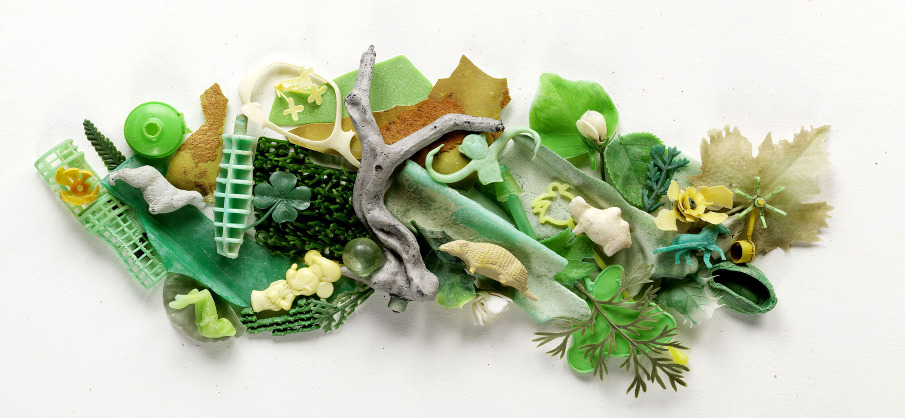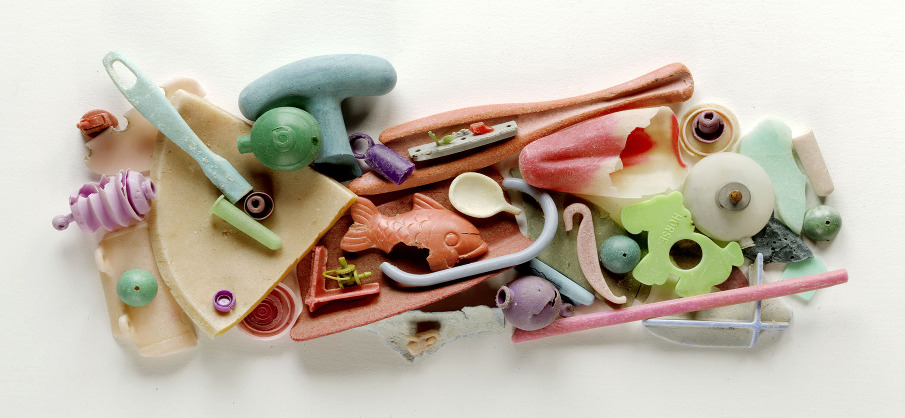“The opposite of beauty really is not ugly; the opposite of beauty is indifference. And we’re trying not to be indifferent about this and about the world.” ~ Richard Lang.

Photo provided by Judith and Richard Lang.
For 15 years, Richard Lang and Judith Selby Lang have been visiting Kehoe Beach in the Point Reyes National Seashore. They collect plastic debris from a set stretch of beach 1000 yards long. Instead of sending this debris to the magical “away” land of garbage landfills, they craft the colorful pieces into stunning works of plastic art. By converting this beach waste into beauty, they expose viewers to a new perspective of human culture.
Garbage becomes art and indifference becomes realization, encouraging us to re-examine the way we look at our consumption of plastic. Each piece of plastic has a story to tell, and Judith and Richard are excellent storytellers. Their plastic art has raised tremendous awareness of plastic pollution by enticing people to experience the aesthetic pleasure of their beach plastic artwork.
One Plastic Beach from High Beam Media via Vimeo.
What sparked your interest in picking up plastic from beaches?
Richard – When we met back in 1998, our very first date was on Kehoe Beach. Judith picked up a piece of plastic off the sand and I asked, “Are you going to keep that?” It was then that we discovered that we both had been picking up beach trash for years.
Judith – My career as art teacher required travel to convalescent homes every week. During my journey to and from these convalescent homes I would sit and have my lunch at Blackie’s Pasture in Tiburon. One day while I was having my lunch, I started noticing the plastic debris that was washing ashore from Richardson Bay. I saw the bright colors and had the thought that maybe I could do something artistic with these colorful pieces. I was always on the search for new art materials and here was plenty of it – so I began collecting it. I did this for several years before I met Richard.

Photo provided by Judith and Richard Lang.
Richard – Back in ’96, my son Eli was at Drake High School and we were volunteering with the park service to do habitat restoration at Kehoe Beach. We walked down to the beach and say, “WOW, there’s a lot of trash down here!” We went back up, grabbed some bags, and began picking up some of the trash. At the end of the day we carried seven bags of trash out. We took the bags and placed them in the trash bin to be sent away. But then I began thinking, what is this “away”? When we throw trash away it makes us feel good because it just disappears and we don’t have to deal with it anymore. This “away” is a magical place that doesn’t really exist. All that garbage is still around, it’s just crammed into landfills.
So we decided to do something useful with the trash. We sorted out the plastic and noticed the incredible colors. We began taking photos to capture these colors, turning plastic waste into plastic art.
Have you tried to keep track of how much plastic you’ve picked up over the years?
Judith – We did try to do a quantitative count for awhile, but that didn’t last very long. We’re not really into the scientific method side of things, just the artistic. When people ask us this question, we like to say we’ve collected “hella” plastic!

Photo provided by Judith and Richard Lang.
What are some of the most common items you pick up? What have been the most interesting or unusual?
Richard – The most common items are shotgun shell wads, cigarillo tips, lids from every container imaginable, agriculture ties for grapevines, balloons, wrappers from candy and other snacks, plastic bottles, and straws.
The type and amount of items we collect are dynamic. A few years ago we started coming across these little red plastic sticks and we couldn’t figure out what they were until one day my daughter Amelia says, “Dummy, those are what you use to spread cheese!” Turns out these little red sticks were the ones that come in the Kraft packages of crackers and cheese. We’ve also seen increasing numbers of those little green splash guards from Starbucks, and this past year we’ve seen tremendous amounts of candy, chip, and other snack wrappers.
We have definitely come across some unusual items, including two of the little plastic Monopoly houses and a ballot box lid from the 2001 San Francisco election.
In what ways have you been able to portray your plastic art to the public? What do you hope your artwork accomplishes by being displayed?
Judith – Our artwork has been featured in shows all over the world, ten videos of our work have been made, we’ve reached out to international communities of artists. Locally, we’ve built exhibits for The Marine Mammal Center and the California Academy of Sciences, as well as many galleries. The greatest accomplishment in our minds is that it reaches beyond the traditional art gallery. We were driving down the highway the other day and we saw one of our pieces on the back of a bus. It was incredible to see it in that context, where it can reach such a wide audience.
Richard – The message we’re trying to convey is that you can apply that beauty to anything. People who are engaged with aesthetic pleasure feel a greater connection with the piece. With our artwork, we encourage people to be anthropologists of their own lives and examine their own usage of plastic. We don’t really notice how much we use until we stop to think about it and our work makes them think.
Tell us about the work behind helping create the exhibit Built for Speed at the California Academy of Sciences.

Photo provided by Judith and Richard Lang.
Richard – We were thrilled to be commissioned to create three Ocean Action Stations that speak about the most pressing ocean issues of today – plastic waste, unsustainable fishing practices, and wastewater pollution. As artists it has been an incredible opportunity for us to bring our vision and skills into the realm of science.
The “Savvy with Seafood” station was a chance to portray something that we both care deeply about. Some years ago we were able to meet and chat with Sylvia Earle, and she inspired us to give the ocean a “break” and we gave up eating fish – though not very happily. For this exhibit we used a bit of humor and portrayed Penultimate Salmon and cans of fish meat that read, “now with added cetaceans,” as a play on bycatch. These pieces served to bring home some very important messages about our fisheries and it was so visible, with thousands of people moving through the Academy. All the materials we used were sourced as much as possible from Kehoe Beach – including the fishing gear and netting.

Photo provided by Judith and Richard Lang.
What projects do you have planned for the future?
Richard – We’ve been working on a book for a long time, and we’ve used the Plastic Forever blog as place keeper. We’d like to find unidentifiable objects and write about them. Every tiny piece of plastic tells us a huge story. For example, the little red cheese sticks tell a story about the food industry and consumption. The Monopoly houses carry a message of greed and domination over others.
Judith – Next month we’re presenting at the Global Philanthropy Conference and we’ll have an exhibit there where people can see and touch plastic items that became beach trash, things they might use in their daily lives. Conference participants will be able to make their own piece of jewelry from the plastic bits. Not only do they make colorful and interesting jewelry, but they have the unfailing ability to start a conversation. Intrigue and beauty are enticing to people, and we want them to be able to take ownership and tell the story of their pieces of plastic jewelry.
It’s easy to fall into a pit of despair. It’s difficult to imagine that there is a floating soup of plastic pieces in the middle of the Pacific ocean – how do we even begin to think about it? We keep the motivation by focusing on what we can do, bit by bit. We’ve even made it a competition to keep going on Kehoe Beach, where we see who can find the best piece of the day. If we can touch it, see it, then we can do something about it.
What have been your favorite art pieces that you’ve created?
Richard – We found a couple hundred soldiers on the beach over the span of a few years. Then we started looking at their faces. If you take a close-up photograph, their faces are actually very poignant. They convey an important message about war, oil, and plastic. They are all intertwined and these little abandoned soldiers reflect this idea and help us portray the true cost of plastic. Each soldier reminds us of the ravages of war and the extremes to which nations go to vie for control of oil resources. These have been our favorite pieces.

Photo provided by Judith and Richard Lang.

Photo provided by Judith and Richard Lang.
Plastic forever
Plastic is not this ugly thing that we don’t like or appreciate. It’s an incredible, valuable resource that we use every day in hospitals, cars, and any modern technology. It’s the idea that we live in a carbon-based culture and we treat plastic like it’s disposable. Plastic is NOT cheap and should not be created as a throwaway resource.
The striking artwork created by Judith and Richard Lang provide us with aesthetic pleasure, yet it carries a tremendously powerful message. Every bottle cap, every straw, every cheese stick should cause us to examine our own lives and decide when and where these items have come from our hands and what we should do about it. We urge you to start a conversation about plastic and help spread the message. If we hope to conserve the marvelous natural resources of our oceans, we must stop plastic pollution. Whether you are an individual or a corporation, each and every human entity has the ability to make smarter choices. Join Pucci Foods in the fight to conserve our natural resources and choose sustainable seafood.


